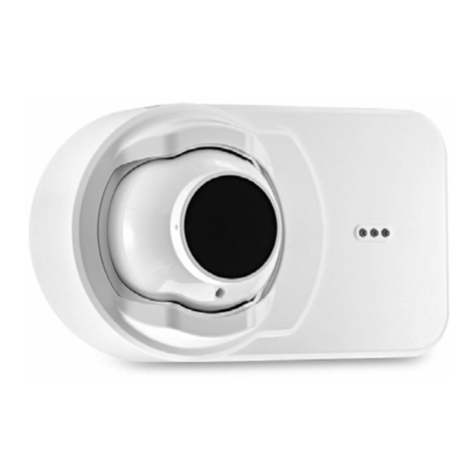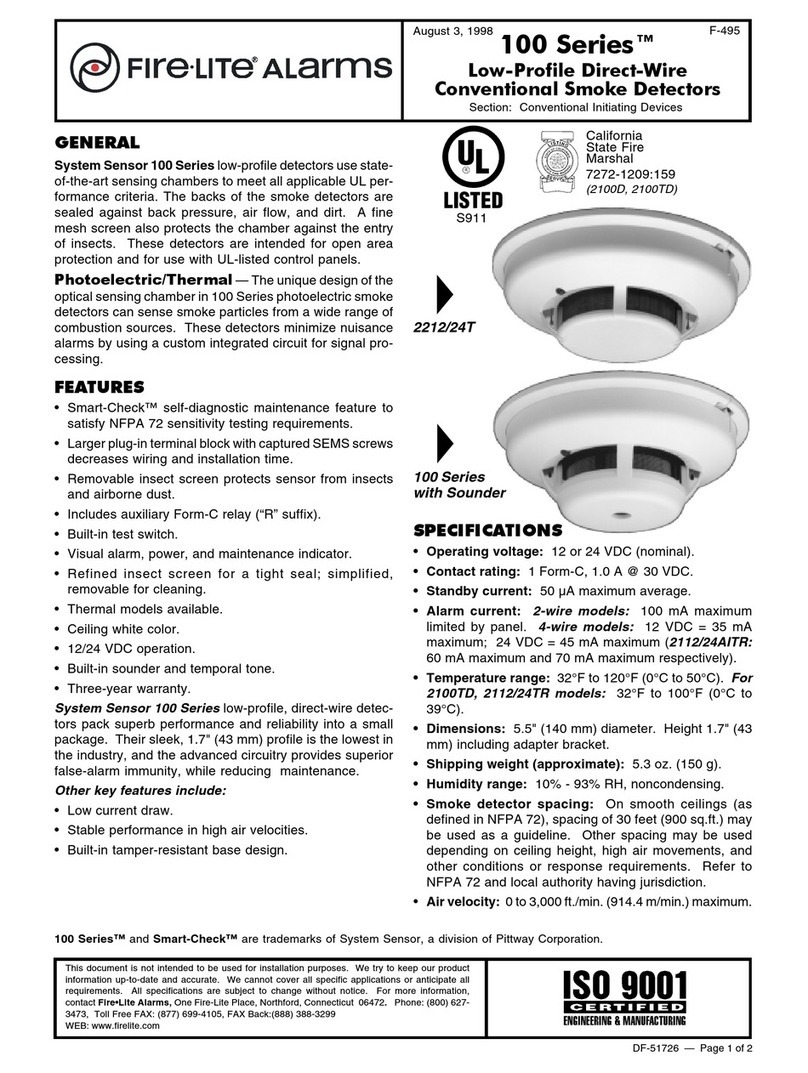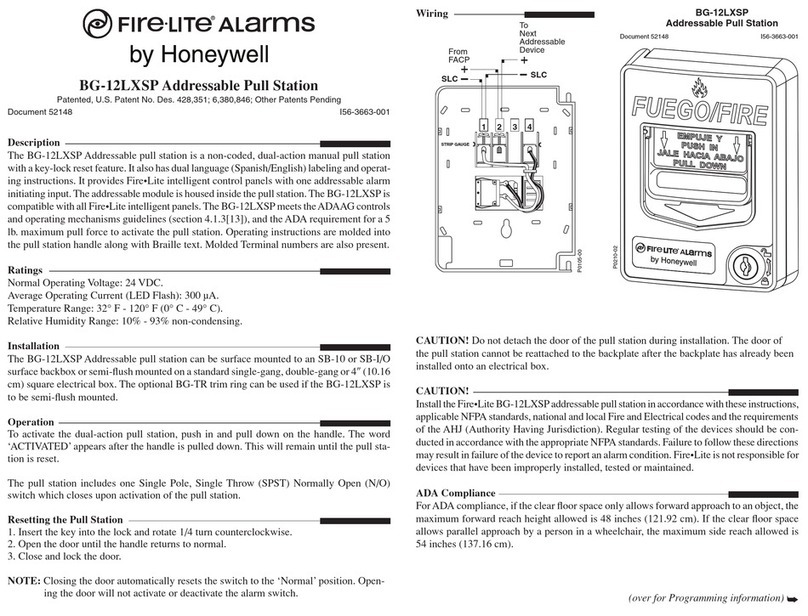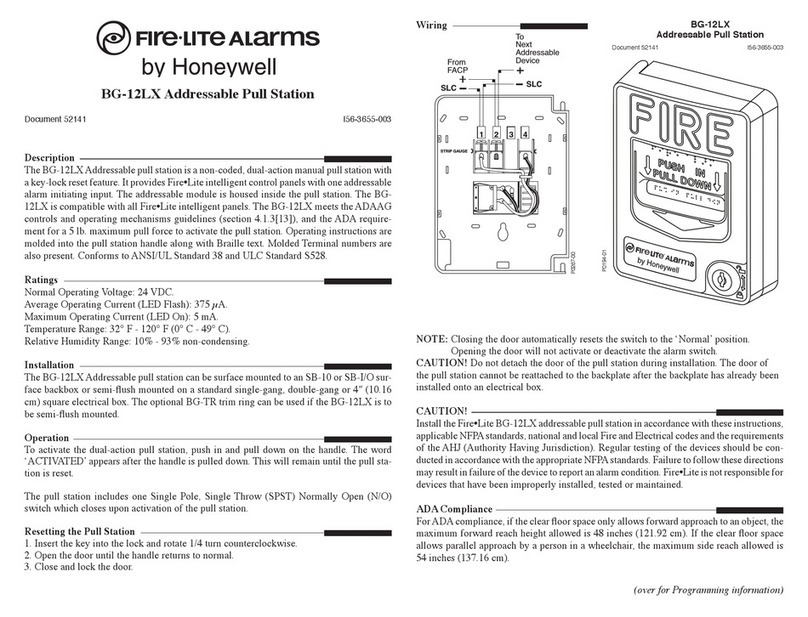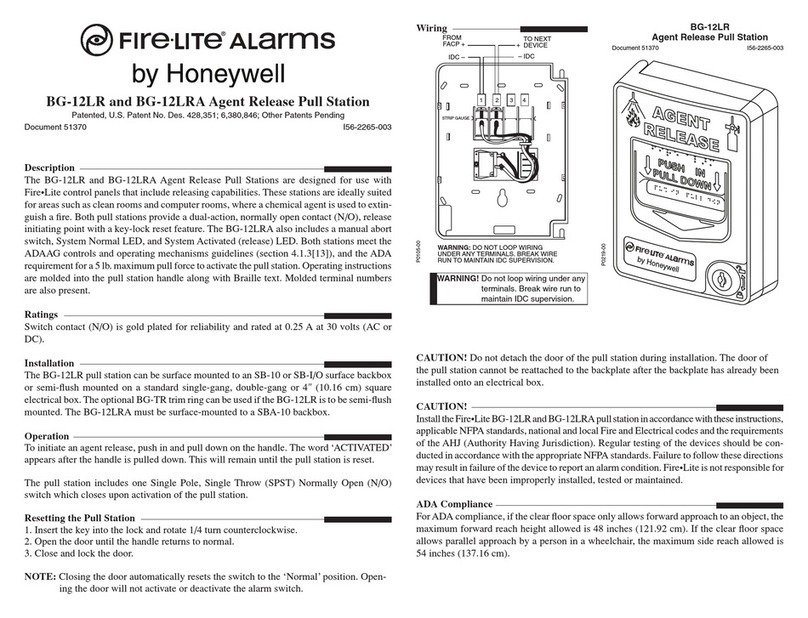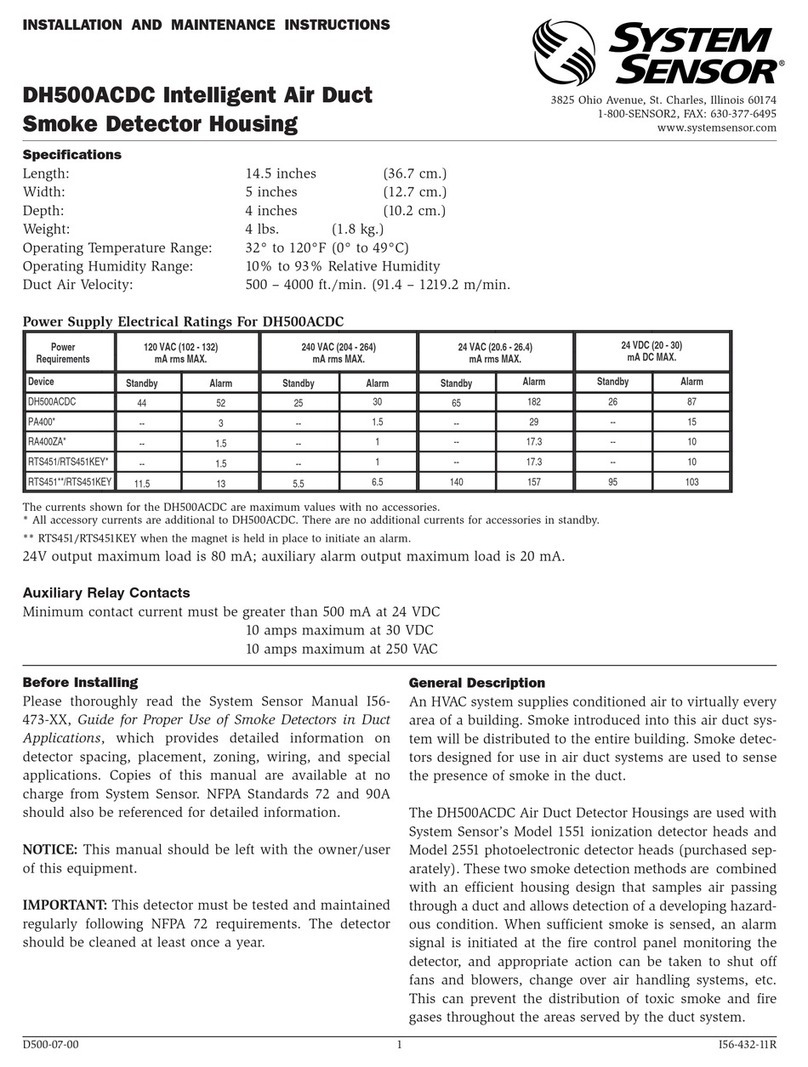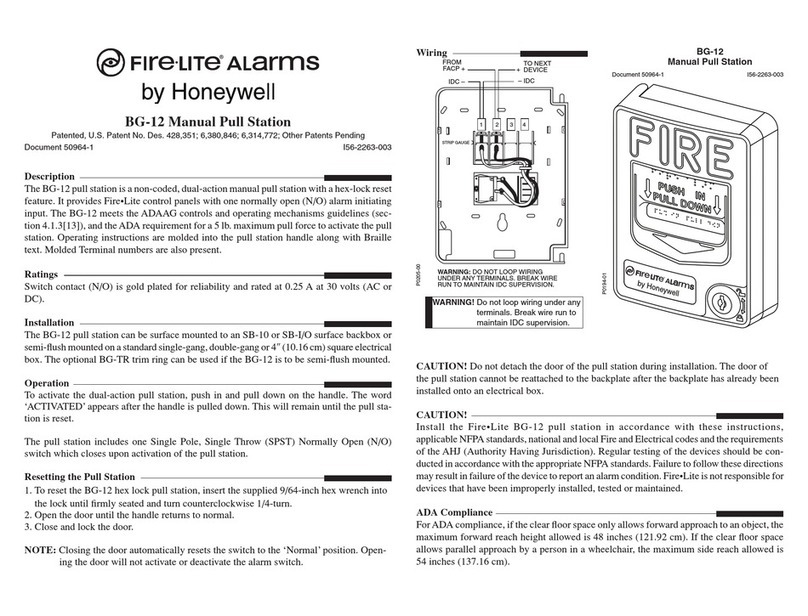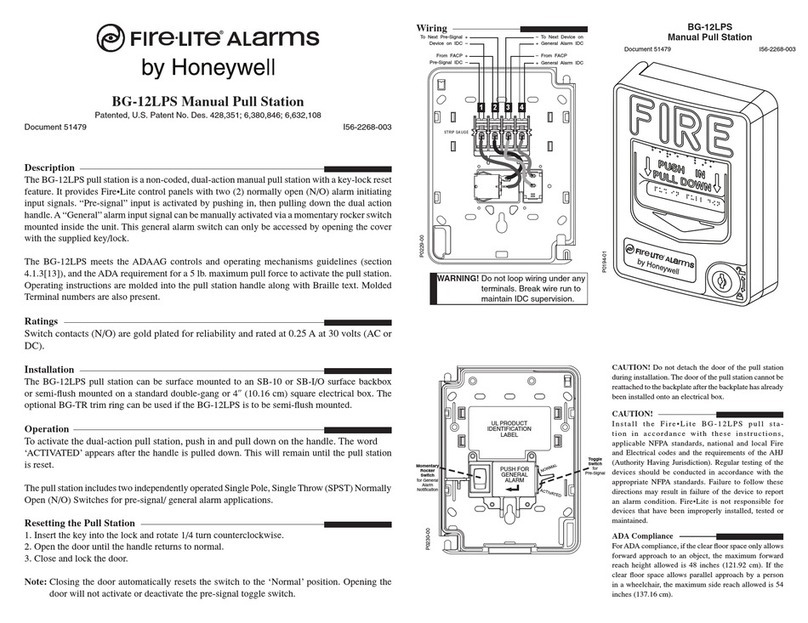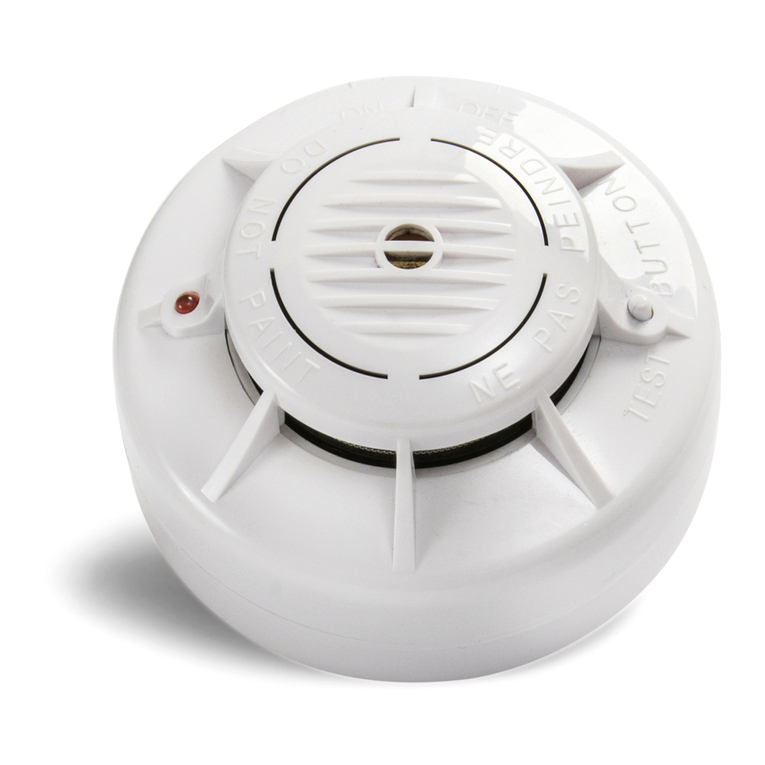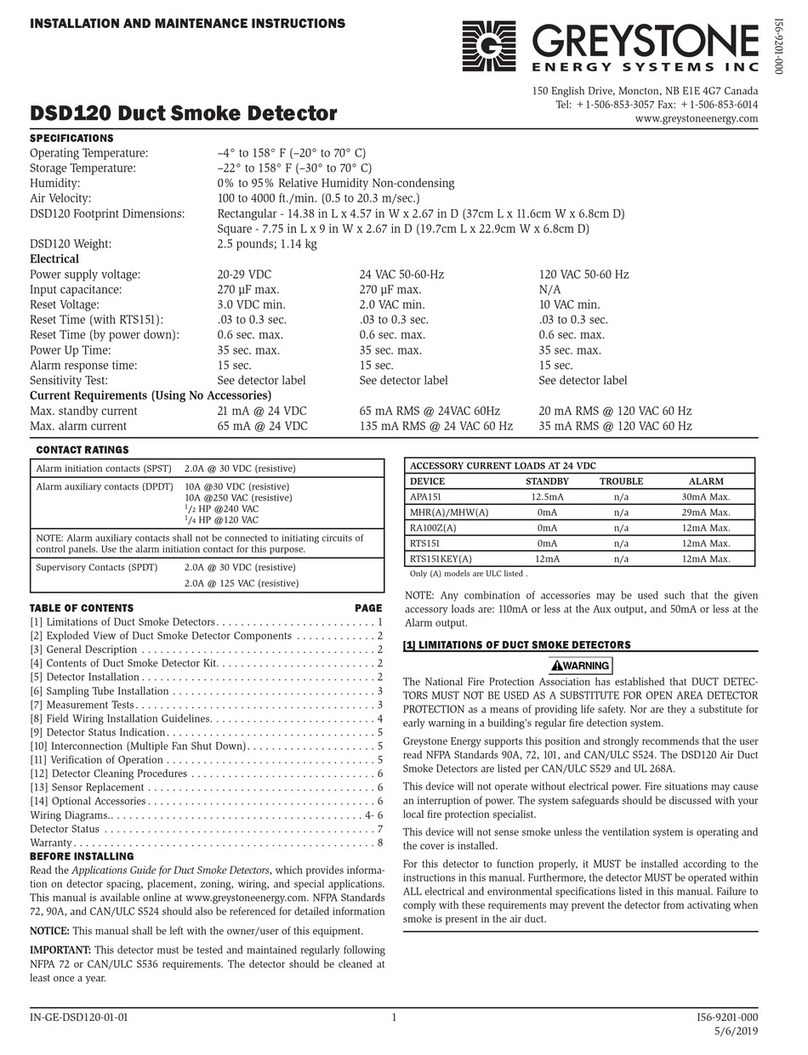
[9.1.1] Smoke Response
To determine if smoke is capable of entering the sensing chamber, visually identify any obstructions. Plug the exhaust
and sampling tube holes to prevent ducted air from carrying smoke away from the detector head, then blow smoke such
as cigarette, cotton wick, or punk directly at the head to cause an alarm. REMEMBER TO REMOVE THESE PLUGS
AFTER THIS TEST, OR THE DETECTOR WILL NOT FUNCTION PROPERLY.
[9.1.2] Filter Replacement
The filters do not substantially affect smoke performance even when up to 90% of the filter is clogged. Quarterly visual
inspection usually suffices to determine whether the filters should be replaced because only a high percentage of con-
tamination affects performance. If further testing is required, compare differential pressure readings with and without the
filters installed using a manometer. If the difference exceeds 10%, replace the filters. In no case should the pressure
differential fall below 0.03 inches of water.
[9.2] Standby, Alarm, And Sensitivity Tests
[9.2.1] Standby And Trouble
Standby — If programmed by the system control panel, look for the presence of the flashing LEDs through the transpar-
ent housing cover. The LED will flash with each communication.
Trouble — If programmed by the system control panel and the detector LEDs do not flash, then the detector lacks
power (check wiring, panel programming, or power supply), the detector board is missing (replace), or the
unit is defective (return for repair).
Test — The trouble condition can be caused intentionally to verify correct operation of the system. Remove the
detector board to cause a trouble condition locally and at the system control panel.
F300-10-00 6 I56-0020-004R
Figure 8. Wiring Diagram for D350P Duct Smoke Detector using a UL listed control panel
Figure 10. System Wiring Diagram for D350P Duct
Smoke Detector with RTS451/RTS451KEY
Figure 9. Wiring Diagram for D350P Duct Detector
with optional RA400Z
Accessory Current Loads at 24VDC
COIL NOTE
Please note that the magnetic coil supplied with the RTS451 and
RTS451KEY is not required when these accessories are used with
the D350P detectors. The functionality of the magnetic coil has been
designed into the circuitry of the duct smoke detector.
[3] Secure The Detector Housing To The Duct
Slide the foam gaskets over the tube bushings as shown
in Figure 3. Use the two 11/4” long sheet metal screws to
screw the detector housing to the duct.
CAUTION: Do not overtighten the screws.
[4] Sampling Tube Installation for Ducts Greater Than
11⁄2 Feet Wide
The sampling tube is identified by a series of air inlet holes
on the tube. A plastic tube is included for ducts up to 11⁄2
feet wide. All other lengths must be purchased separately.
Order the correct length, as specified in Table 1, for width
of the duct where it will be installed. It is recommended
that the sampling tube length extend at least 2⁄3 across the
duct width for optimal performance. The exhaust tube is
molded onto the base of the duct housing, and the A2440-
00 Exhaust Tube Extension is available as an accessory
in those cases where the molded exhaust port does not
extend at least 2 inches into the duct.
The sampling tube is always installed with the air inlet
holes facing into the air flow. To assist proper installation,
the tube’s mounting flange is marked with an arrow. Make
sure the sampling tube is mounted so that the arrow points
into the air flow (see Figure 4). Figure 5 shows the various
combinations of tube mounting configurations with respect
to air flow. Mounting the detector housing in a vertical ori-
entation is acceptable, provided that a metal sampling tube
is used and the air flows directly into the sampling tube
holes as indicated in Figure 4.
[4.1] Installation For Ducts Greater Than 11⁄2 Feet But
Less Than 8 Feet Wide
1. If the tube is longer than the width of the air duct, drill a 3⁄4″
hole in the duct opposite the hole already cut for the sam-
pling tube. Make sure the hole is 1″ to 2″ below the inlet
hole on the opposite side of the duct to allow moisture
drainage away from the detector. If the tube is shorter
than the width of the air duct, install the end cap into the
sampling tube as shown in Figure 4. Sampling tubes over
3 ft. long must be supported at the end opposite the duct
smoke detector.
2. Slide the tube into the housing bushing that meets
the air flow first. Position the tube so that the arrow
points into the air flow, as shown in Figure 4.
3. Secure the tube flange to the housing bushing with two
#6 self-tapping screws.
4. For tubes longer than the width of the air duct, the tube
should extend out of the opposite side of the duct. If
there are more than 2 holes in the section of the tube
extending out of the duct, select a different length using
Table 1. Otherwise, trim the end of the tube protruding
through the duct so that 1
″
to 2
″
of the tube extend out-
side the duct. Plug this end with the end cap and tape
closed any holes in the protruding section of the tube.
Be sure to seal the duct where the tube protrudes.
F300-10-00 3 I56-0020-004R
Figure 3. Installation of foam gaskets over sampling
tube bushings:
Figure 5. Tube mounting configurations with varying
air flow direction:
Table 1. Sampling tubes recommended for different
duct widths:
Outside Duct Width Sampling Tube Recommended*
1 to 2 ft. (0.3 to 0.6 m) ST-1.5
2 to 4 ft. (0.6 to 1.2 m) ST-3
4 to 8 ft. (1.2 to 2.4 m) ST-5
8 to 12 ft. (2.4 to 3.7 m) ST-10
*Must extend a minimum of 2⁄3 the duct width.
Figure 4. Air duct detector sampling tube:
NOTE: Only metal sampling tubes can be installed in
orientations C and D.
A78-2703-00
SCREW HOLES FOR
ATTACHING HOUSING
TO DUCT WORK.
SAMPLING
TUBE
END CAP
AIR HOLES
ARROW
MUST FACE
INTO AIR FLOW
AIR FLOW DIRECTION
FLANGE
AIR FLOW
DIRECTION
DETECTOR
HOUSING
DOTS INDICATE POSITION OF
SAMPLING TUBE HOLES
AIR FLOW
DIRECTION
DETECTOR
HOUSING
SAMPLING
TUBE
EXHAUST
TUBE
AIR FLOW
DIRECTION
EXHAUST
TUBE
SAMPLING
TUBE
SAMPLING
TUBE
EXHAUST
TUBE
DETECTOR
HOUSING
AIR FLOW
DIRECTION
DETECTOR
HOUSING
A. B.
C. D.
HORIZONTAL MOUNTING OF HOUSING
VERTICAL MOUNTING OF HOUSING
NOTE: The sampling tube end cap is critical to the proper
operation of the duct smoke detectors. The end cap is
needed to create the proper air flow to the sensor of the
duct smoke detector.
TEST
RA400Z
RTS451
KEY
COMMON
COM(+)
COM(–)
TEST
RA400Z
RTS451
KEY
COMMON
COM(+)
COM(–)
+
–
COM (+)
COM (–)
COM (+)
COM (–)
COMMUNICATION
LINE
UL LISTED CONTROL
PANEL
1ST DETECTOR
IN LOOP
2ND DETECTOR
IN LOOP
DEVICE STANDBY ALARM
RA400Z 0mA 10 mA Max.
RTS451/RTS451KEY 0mA 7.5 mA Max.
TEST
RA400Z
RTS451
KEY
COMMON
COM(+)
COM(-)
RA400Z
COMMON
+–
DH200P RA400Z
TEST
RA400Z
RTS451
KEY
COMMON
COM(+)
COM(-)
RA400Z
COMMON
TEST
RTS451
KEY
COM(+)
COM(-)
456
12 3
FIELD INSTALLED
JUMPER
COMMON TEST
LED RESET
FOR RTS451, TERMINAL 3 IS NOT USED.
(RTS451 DOES NOT HAVE A TERMINAL 6.)
FOR RTS451KEY, TERMINALS 3 AND 6
ARE NOT USED.
DH200P RTS451/RTS451KEY

